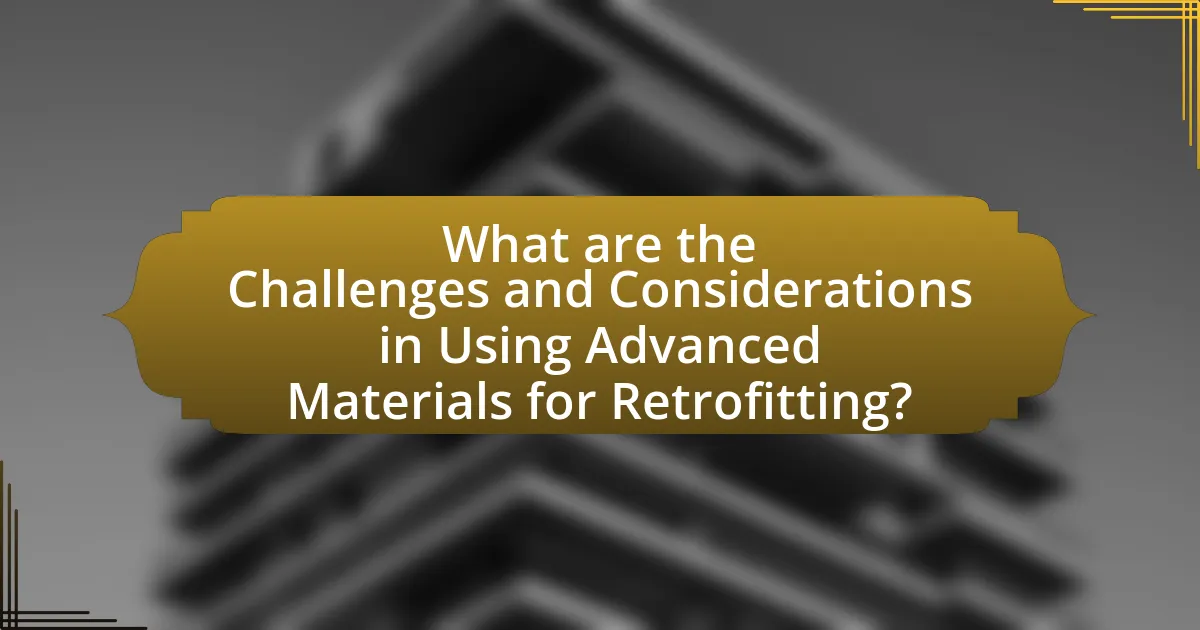The article focuses on the role of advanced materials in retrofitting historic structures, emphasizing their significance in enhancing structural integrity while preserving aesthetic and historical values. It discusses the differences between advanced and traditional materials, highlighting properties such as strength, durability, and lightweight characteristics that make advanced materials suitable for retrofitting. Key advanced materials, including fiber-reinforced polymers and high-performance concrete, are examined for their effectiveness in improving energy efficiency and extending the lifespan of historic buildings. The article also addresses challenges in retrofitting, such as compatibility with existing structures and regulatory compliance, while outlining best practices for successful integration of these innovative materials.

What are Advanced Materials and Their Importance in Retrofitting Historic Structures?
Advanced materials are innovative substances engineered to possess superior properties, such as enhanced strength, durability, and lightweight characteristics, which are crucial for retrofitting historic structures. Their importance lies in their ability to improve structural integrity while preserving the aesthetic and historical value of these buildings. For instance, materials like fiber-reinforced polymers and high-performance concrete can provide additional support without compromising the original design, allowing for compliance with modern safety standards. Studies have shown that using advanced materials can extend the lifespan of historic structures by up to 50%, demonstrating their effectiveness in maintaining both functionality and heritage.
How do advanced materials differ from traditional materials in construction?
Advanced materials differ from traditional materials in construction primarily through their enhanced properties, such as increased strength, durability, and lightweight characteristics. For instance, advanced materials like carbon fiber composites and high-performance concrete offer superior tensile strength compared to traditional materials like wood and standard concrete, allowing for more innovative designs and structural efficiency. Additionally, advanced materials often exhibit better resistance to environmental factors, such as corrosion and temperature fluctuations, which can significantly extend the lifespan of structures. Research indicates that using advanced materials can reduce maintenance costs and improve energy efficiency, making them a more sustainable choice in modern construction practices.
What properties make advanced materials suitable for retrofitting?
Advanced materials are suitable for retrofitting due to their high strength-to-weight ratio, durability, and adaptability. These materials, such as fiber-reinforced polymers and advanced composites, provide enhanced structural integrity while minimizing additional load on existing structures. Their resistance to environmental factors, such as moisture and corrosion, ensures longevity and reduces maintenance needs. Furthermore, advanced materials can be engineered to match the specific mechanical properties required for different applications, allowing for tailored solutions that preserve the aesthetic and historical value of the structures being retrofitted.
How do advanced materials enhance the structural integrity of historic buildings?
Advanced materials enhance the structural integrity of historic buildings by providing superior strength, flexibility, and durability compared to traditional materials. These materials, such as carbon fiber-reinforced polymers and high-performance concrete, can be used to reinforce existing structures without compromising their historical value. For instance, carbon fiber can be applied to strengthen load-bearing elements, allowing for increased load capacity and resistance to environmental stresses. Studies have shown that using these advanced materials can significantly reduce the risk of structural failure, as evidenced by the successful retrofitting of the historic San Francisco Ferry Building, which utilized advanced composites to improve seismic performance.
Why is retrofitting necessary for historic structures?
Retrofitting is necessary for historic structures to enhance their structural integrity and ensure safety against natural disasters, such as earthquakes and floods. Many historic buildings were constructed using materials and techniques that do not meet modern safety standards, making them vulnerable to damage. For example, the National Park Service reports that retrofitting can significantly reduce the risk of collapse during seismic events, preserving both the structure and its historical significance. Additionally, retrofitting can improve energy efficiency, which is increasingly important for sustainability in heritage conservation.
What challenges do historic structures face that necessitate retrofitting?
Historic structures face challenges such as structural deterioration, inadequate seismic resistance, and energy inefficiency that necessitate retrofitting. Structural deterioration occurs due to age, weathering, and material degradation, which can compromise the integrity of the building. Inadequate seismic resistance is a significant concern, especially in earthquake-prone areas, where older buildings may not meet modern safety standards. Additionally, energy inefficiency in historic structures often leads to high operational costs and increased carbon footprints, prompting the need for retrofitting to improve insulation and energy performance. These challenges highlight the importance of retrofitting to preserve historic integrity while enhancing safety and sustainability.
How does retrofitting contribute to the preservation of cultural heritage?
Retrofitting contributes to the preservation of cultural heritage by enhancing the structural integrity and functionality of historic buildings while maintaining their original aesthetic and historical significance. This process often involves the use of advanced materials, such as fiber-reinforced polymers and high-performance concrete, which provide strength and durability without compromising the building’s character. For instance, a study by the National Park Service highlights that retrofitting can extend the lifespan of heritage structures, allowing them to withstand environmental stresses and modern usage demands, thereby ensuring their continued relevance and preservation for future generations.
What role do advanced materials play in the retrofitting process?
Advanced materials play a crucial role in the retrofitting process by enhancing the structural integrity and energy efficiency of historic buildings. These materials, such as fiber-reinforced polymers and high-performance insulation, provide strength without adding significant weight, allowing for the preservation of the original architecture while improving load-bearing capacity. For instance, studies have shown that using carbon fiber-reinforced polymers can increase the tensile strength of existing structures by up to 50%, enabling them to better withstand seismic forces. Additionally, advanced materials contribute to sustainability by improving thermal performance, which can reduce energy consumption by as much as 30% in retrofitted buildings.
How are advanced materials integrated into existing structures?
Advanced materials are integrated into existing structures through techniques such as bonding, layering, and reinforcement. These methods allow for the enhancement of structural integrity and performance without compromising the original design. For example, carbon fiber reinforced polymers (CFRP) can be applied to the surface of beams and columns to increase load-bearing capacity, as demonstrated in various retrofitting projects where CFRP has improved the seismic resilience of historic buildings. Additionally, the use of advanced composites can facilitate the repair of cracks and deterioration in masonry, ensuring longevity while preserving historical aesthetics.
What are the benefits of using advanced materials in retrofitting projects?
The benefits of using advanced materials in retrofitting projects include enhanced structural integrity, improved energy efficiency, and increased durability. Advanced materials, such as fiber-reinforced polymers and high-performance concrete, provide superior strength-to-weight ratios, allowing for significant load-bearing improvements without adding excessive weight. Additionally, these materials often have better thermal insulation properties, which can lead to reduced energy consumption and lower utility costs. For instance, studies have shown that retrofitting with advanced materials can improve energy efficiency by up to 30%. Furthermore, advanced materials are often more resistant to environmental factors, such as moisture and corrosion, extending the lifespan of retrofitted structures and reducing maintenance costs over time.
How can the use of advanced materials improve energy efficiency in historic buildings?
The use of advanced materials can significantly improve energy efficiency in historic buildings by enhancing insulation, reducing air leakage, and optimizing energy consumption. For instance, materials such as aerogels and phase change materials provide superior thermal insulation compared to traditional options, allowing historic structures to maintain stable indoor temperatures with less energy expenditure. Additionally, advanced glazing technologies, like low-emissivity (low-E) windows, minimize heat loss while preserving the aesthetic integrity of historic facades. Studies have shown that retrofitting historic buildings with these materials can lead to energy savings of up to 30% or more, demonstrating their effectiveness in improving energy efficiency while respecting the building’s historical value.
What are the environmental impacts of using advanced materials in retrofitting?
The environmental impacts of using advanced materials in retrofitting include reduced energy consumption, lower carbon emissions, and improved resource efficiency. Advanced materials, such as high-performance insulation and energy-efficient glazing, enhance the thermal performance of buildings, leading to significant energy savings. For instance, studies indicate that retrofitting with advanced materials can reduce energy use by up to 30% in historic structures, thereby decreasing greenhouse gas emissions associated with heating and cooling. Additionally, these materials often have a longer lifespan and require less maintenance, which contributes to resource conservation over time.

What are the Types of Advanced Materials Used in Retrofitting Historic Structures?
The types of advanced materials used in retrofitting historic structures include fiber-reinforced polymers (FRP), high-performance concrete, and shape memory alloys. Fiber-reinforced polymers are lightweight and provide high tensile strength, making them ideal for reinforcing existing structures without adding significant weight. High-performance concrete offers enhanced durability and strength, allowing for improved load-bearing capacity and resistance to environmental factors. Shape memory alloys can adapt to stress and strain, providing dynamic support and flexibility in structural applications. These materials have been validated through various case studies, demonstrating their effectiveness in preserving the integrity of historic buildings while enhancing their structural performance.
What are the most common advanced materials utilized in retrofitting?
The most common advanced materials utilized in retrofitting include fiber-reinforced polymers (FRP), high-performance concrete, and shape memory alloys (SMA). Fiber-reinforced polymers are widely used due to their high strength-to-weight ratio and corrosion resistance, making them ideal for strengthening existing structures. High-performance concrete offers enhanced durability and load-bearing capacity, which is crucial for retrofitting aging buildings. Shape memory alloys provide unique properties that allow them to return to their original shape after deformation, making them effective for seismic retrofitting. These materials have been validated through numerous case studies demonstrating their effectiveness in improving structural integrity and extending the lifespan of historic structures.
How do fiber-reinforced polymers contribute to structural reinforcement?
Fiber-reinforced polymers (FRPs) contribute to structural reinforcement by enhancing the load-bearing capacity and durability of existing structures. FRPs are lightweight yet possess high tensile strength, allowing them to effectively transfer loads and resist tensile forces. For instance, studies have shown that when applied to concrete beams, FRPs can increase load capacity by up to 50%, significantly improving structural performance. Additionally, FRPs are resistant to corrosion, which is crucial for preserving historic structures exposed to environmental degradation. This combination of strength and durability makes FRPs an effective solution for retrofitting and reinforcing aging infrastructures.
What role do nanomaterials play in enhancing durability?
Nanomaterials significantly enhance durability by improving the mechanical properties and resistance to environmental degradation of materials used in construction. Their unique properties, such as increased surface area and strength at the nanoscale, allow for better bonding and reinforcement within composite materials. For instance, the incorporation of nanosilica in concrete has been shown to increase compressive strength and reduce permeability, leading to longer-lasting structures. Studies indicate that nanomaterials can also mitigate the effects of corrosion and weathering, thereby extending the lifespan of retrofitted historic structures.
How do smart materials enhance the retrofitting process?
Smart materials enhance the retrofitting process by providing adaptive responses to environmental changes, improving structural performance and longevity. These materials, such as shape memory alloys and piezoelectric materials, can change their properties in response to stress, temperature, or moisture, allowing for real-time adjustments that traditional materials cannot achieve. For instance, shape memory alloys can return to a predetermined shape when heated, which can help in restoring the integrity of historic structures after deformation. Additionally, the use of smart materials can lead to reduced maintenance costs and increased energy efficiency, as they can actively respond to load changes and environmental conditions, thereby prolonging the lifespan of retrofitted buildings.
What are the benefits of using self-healing materials in historic structures?
The benefits of using self-healing materials in historic structures include enhanced durability, reduced maintenance costs, and preservation of structural integrity. Self-healing materials can autonomously repair cracks and damage, which is particularly valuable in historic buildings that require careful preservation. For instance, studies have shown that these materials can significantly extend the lifespan of structures by preventing further deterioration, thus maintaining their historical value and aesthetic appeal. Additionally, the use of self-healing materials can lead to lower long-term repair costs, as they minimize the need for frequent interventions and extensive restoration efforts.
How do phase-changing materials improve thermal performance?
Phase-changing materials (PCMs) improve thermal performance by absorbing and releasing thermal energy during phase transitions, such as melting and solidifying. This property allows PCMs to regulate indoor temperatures by storing excess heat when temperatures rise and releasing it when temperatures drop, thus enhancing energy efficiency. Studies have shown that integrating PCMs into building materials can reduce energy consumption for heating and cooling by up to 30%, demonstrating their effectiveness in maintaining stable thermal conditions in historic structures.

What are the Challenges and Considerations in Using Advanced Materials for Retrofitting?
The challenges and considerations in using advanced materials for retrofitting include compatibility with existing structures, cost implications, and regulatory compliance. Compatibility is crucial as advanced materials must bond effectively with historic materials to ensure structural integrity; for instance, using carbon fiber reinforced polymers can enhance strength but may not adhere well to traditional masonry. Cost implications arise from the initial investment in advanced materials, which can be significantly higher than conventional options, potentially deterring projects despite long-term benefits. Regulatory compliance is another challenge, as retrofitting historic structures often requires adherence to preservation guidelines, which may restrict the use of certain advanced materials. These factors collectively influence the decision-making process in retrofitting historic structures.
What are the potential drawbacks of using advanced materials in historic retrofitting?
The potential drawbacks of using advanced materials in historic retrofitting include compatibility issues, aesthetic concerns, and regulatory challenges. Compatibility issues arise when modern materials do not interact well with traditional building materials, potentially leading to structural problems or accelerated deterioration of the historic elements. Aesthetic concerns can emerge if advanced materials alter the visual character of a historic structure, undermining its historical integrity. Regulatory challenges often involve strict preservation guidelines that may restrict the use of certain advanced materials, complicating the retrofitting process. These drawbacks highlight the need for careful consideration and planning when integrating advanced materials into historic retrofitting projects.
How do costs compare between advanced materials and traditional methods?
Costs for advanced materials are generally higher than those for traditional methods. Advanced materials, such as carbon fiber composites and high-performance polymers, often involve greater initial investment due to their specialized manufacturing processes and material properties. For instance, a study by the National Institute of Standards and Technology found that while traditional materials like concrete and steel may cost around $100 per cubic yard, advanced composites can exceed $300 per cubic yard. However, advanced materials can lead to long-term savings through reduced maintenance and increased durability, which can offset their higher upfront costs over time.
What are the regulatory challenges associated with retrofitting historic structures?
Retrofitting historic structures faces significant regulatory challenges primarily due to preservation laws and building codes. Preservation laws, such as the National Historic Preservation Act in the United States, impose strict guidelines on alterations to maintain the historical integrity of a structure. Additionally, local building codes may not accommodate modern materials or techniques used in retrofitting, creating conflicts between safety standards and preservation requirements. These regulations can limit the types of materials that can be used, the methods of construction, and the overall design changes, complicating the retrofitting process.
How can project managers ensure successful integration of advanced materials?
Project managers can ensure successful integration of advanced materials by implementing a structured approach that includes thorough research, stakeholder engagement, and continuous monitoring. Researching the properties and compatibility of advanced materials with existing structures is essential, as it informs decisions on material selection and application methods. Engaging stakeholders, including architects, engineers, and preservationists, fosters collaboration and ensures that all perspectives are considered, which is crucial for maintaining the integrity of historic structures. Continuous monitoring during the integration process allows for real-time adjustments and ensures that the materials perform as expected, thereby minimizing risks associated with retrofitting.
What best practices should be followed during the retrofitting process?
Best practices during the retrofitting process include conducting thorough assessments of the existing structure, selecting appropriate advanced materials, and ensuring compliance with local regulations. Assessments should evaluate structural integrity, historical significance, and potential vulnerabilities, which informs the choice of materials that enhance performance while preserving aesthetics. For instance, using fiber-reinforced polymers can improve strength without adding significant weight, as supported by studies showing their effectiveness in seismic retrofitting. Additionally, adherence to regulations ensures that retrofitting efforts maintain the building’s historical value and safety standards, as outlined in guidelines from organizations like the National Park Service.
How can collaboration with preservationists enhance project outcomes?
Collaboration with preservationists enhances project outcomes by ensuring that retrofitting efforts respect and maintain the historical integrity of structures. Preservationists bring expertise in historical architecture, materials, and techniques, which helps to identify appropriate advanced materials that align with the original design and function of the building. For instance, a study by the National Park Service highlights that projects involving preservationists are more likely to achieve compliance with preservation standards, leading to successful integration of modern materials without compromising historical value. This collaboration ultimately results in projects that are not only structurally sound but also culturally and historically significant.
What are the Future Trends in Advanced Materials for Historic Retrofitting?
Future trends in advanced materials for historic retrofitting include the development of bio-based composites, self-healing materials, and nanomaterials. Bio-based composites, derived from renewable resources, offer sustainable alternatives that can enhance structural integrity while maintaining aesthetic qualities. Self-healing materials, which can autonomously repair damage, improve longevity and reduce maintenance costs, making them ideal for preserving historic structures. Nanomaterials, known for their strength and lightweight properties, enable the reinforcement of existing materials without compromising the original design. These advancements are supported by ongoing research in material science, demonstrating their potential to revolutionize the preservation of heritage buildings while ensuring safety and durability.
What practical tips can be applied when considering advanced materials for retrofitting historic structures?
When considering advanced materials for retrofitting historic structures, it is essential to prioritize compatibility with existing materials. This ensures that the new materials do not adversely affect the structural integrity or aesthetic value of the historic building. For example, using fiber-reinforced polymers can enhance strength without adding significant weight, which is crucial for older structures that may not support heavy loads. Additionally, conducting thorough assessments of the existing materials and structural conditions is vital; this can involve non-destructive testing methods to evaluate the integrity of the original components. Furthermore, selecting materials that offer durability and low maintenance can prolong the lifespan of the retrofit, such as using weather-resistant coatings or corrosion-resistant metals. Lastly, engaging with preservation specialists during the planning phase can help ensure that the retrofitting process adheres to local regulations and preservation standards, thereby maintaining the historical significance of the structure.

Leave a Reply